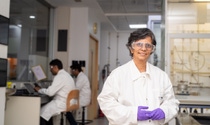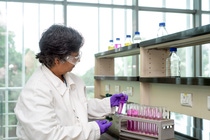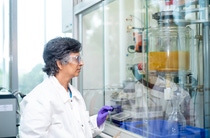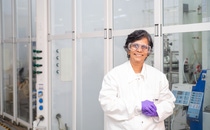Shilpa Korde is a researcher at the Innovation Campus Mumbai. With her endless joy of discovery, she develops new molecules with special properties. She unlocks science's secrets – one dazzling crystal at a time. These new compounds can, for example, protect our skin from the sun and thus from the development of cancer cells.
What exactly are you doing at BASF today?
You could say that I try to invent new molecules that have superpowers. As researcher I’m responsible for the development and optimization of high-performance products and their intermediates, spearheading the innovation pipeline, and fostering collaborative partnerships with academic institutions.

Where can we experience the influence of your research in our everyday lives?
My research encompasses enhancing the performance of existing products and developing innovative solutions with superior functionality, such as UV absorbers. UV absorbers are added to sunscreens, coatings and plastics in order to prevent damage from the UV radiations of the sun to human skin, surfaces and objects. Thus UV absorbers protect humans from developing cancer, automotives colors from fading and plastic objects from yellowing and warping.

How do such UV absorbers protect our skin from burning and extend the life of objects?
As BASF, we are the market leader of high-performance UV light absorbers of the hydroxyphenyl triazine class. They are characterized by a very low volatility and a very high extinction coefficient - this means that they can effectively weaken harmful UV rays through absorption and scattering. One example from cosmetics, microfine dispersion of the BASF UV absorbers makes the strongest contribution to the SPF of skin care applications, such as anti-aging and sun protection. Thanks to its second absorbance maximum in the UVA2 range, they provide strong protection against the harmful effects of the UV radiation.
As another example, when sunlight hits a polycarbonate sheet, the material absorbs the energy of certain wavelengths in the UV range namely UVb and UVa. Photooxidation occurs over time and makes the polycarbonate more fragile and susceptible to surface erosion. Application of an appropriate BASF UV absorber offers the best-in-class solution for the most demanding polycarbonate thin-section in terms of exposure to UV light and heat providing extended lifetime and very low surface roughness after prolonged exposure to harsh climate conditions. This enables reduced maintenance and enhances waste management.

Have you ever had a special moment of happiness in the research?
My journey in research has been laced by moments of profound joy and fulfillment. One such moment was witnessing the crystallization of my first novel molecule, the sight of those shimmering crystals in the test tube was a testament to the power of scientific creation and the thrill of discovery.
Another momentous milestone was when the innovative process developed by my team and I was selected for commercialization. The process, when implemented, will significantly improve the carbon footprint of BASF’s light stabilizers, validating our collective efforts and underscoring the potential of our research to make a meaningful impact on the world.
You work with many research institutes in India. What does that mean to you?
My collaborations with numerous research institutes across India have been a source of inspiration and motivation. The academic environment fosters unfettered exploration and innovation, allowing researchers to pursue their intellectual curiosity without the constraints of rigid targets or budgets. This freedom has nurtured a remarkable level of creativity among my academic counterparts, their ingenuity and unconventional approaches constantly pushing the boundaries of knowledge. Additionally, the infectious enthusiasm and optimism of students during our discussions serve as a testimony of the transformative potential of education and research. One exciting project we pursue together is the development of a biorefinery for horticulture waste valorization.


Why did you want to become a researcher?
From a young age, I possessed an innate curiosity and a tendency for unconventional thinking. This inclination to explore beyond the familiar set the stage for my eventual foray into the realm of research. As I delved deeper into the world of science, I became captivated by the allure of discovery, the prospect of unraveling the mysteries of the universe and unlocking new frontiers of knowledge. This insatiable fascination with the unknown fueled my passion for scientific exploration and propelled me onto the path of research.
Is your curiosity also noticeable in your private life?
Indeed, my family and friends are often exhausted by my incessant stream of 'how come' and 'why' questions. However, my insatiable curiosity and eagerness to experiment with new ideas remain unabated. I am always willing to try out new ‘recipes’.
What do you like to do in your free time?
I like to spend my time at a quiet nature friendly place where I find peace to be able to fantasize some crazy ideas running through my mind.

